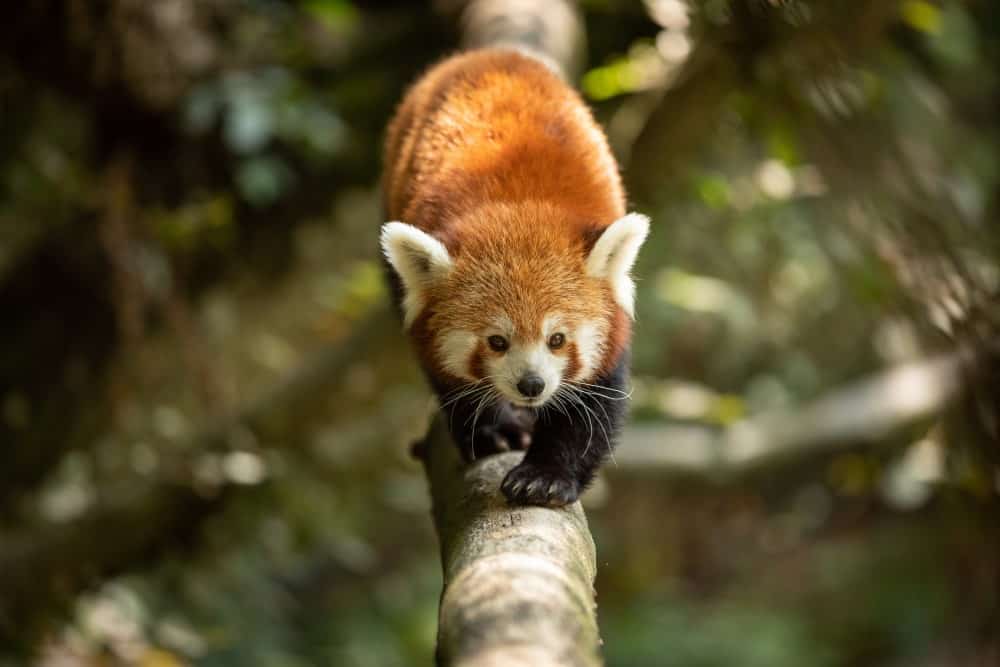28 Fascinating Red Panda Facts
Red Pandas are endearing and steal the show at our local science center. In June of 2022, the pair of red pandas at our local science became parents. It has been fun to visit and watch the veterinarian on staff examine and feed the cub. Let’s look at some red panda facts and get to know these endangered animals.
Table of Contents
Red Panda Facts – Name and Classification Information
- In China, red pandas are called hun-ho, which means firefox. Their scientific name comes from the Greek for cat “ailouros” and Latin “fulgens,” meaning fire.
- Although called the red “panda”, these creatures are neither panda nor bear.
- Their common name is red panda, and their scientific name: Ailurus fulgens.
- Previously thought to be members of the raccoon family, scientists have now placed them within their unique taxonomic group known as Ailuridae, which is a family of the superfamily Musteloidea alongside Mustelidae (Otters, weasels, and badgers), Procyiondae (raccoons, kinkajous, and cacomistles) and Mephitidae (Skunks).
- Ailurus fulgens and Ailurus fulgens styani are believed to be the two subspecies of red panda. But this is still under research, as they were both originally thought to be just subspecies. However, researchers are considering whether they could be two distinct species.
- Ailurus fulgens styani is also called the Himalayan red panda and is larger and brighter, with a redder face and more distinct rings on its tail.

Red Panda Facts – Where Do Red Pandas Live and What Do They Eat?
- Both subspecies of red panda are found throughout Asia, predominantly near the Himalayas.
- Ailurus fulgens styani is found predominantly in Arunachal Pradesh, Myanmar, and parts of China.
- Ailurus fulgens is found in Nepal, northeastern India, Bhutan, and southern Tibet.
- They prefer to live in higher climates, with most being found between 4,000-13,000 feet in elevation. Some have been spotted on Mt. Everest.
- They prefer temperate forests with lots of bamboo to forage.
- While giant pandas prefer to eat the large, tough stalks of bamboo, red pandas prefer to eat the leaves and dig up fresh bamboo shoots.
Red pandas are considered omnivorous. In addition to their bamboo-heavy diet, they also eat roots, small bird eggs, insects, and fruits. They are some of the few animals classified as carnivores who have taste buds that recognize the taste of sweetness.

Red Panda Facts – How Big Do Red Pandas Get & What Are Their Physical Characteristics?
- Most adult red pandas grow to be between 7.5-20 pounds, measuring from nose to tail tip around 35-42 inches, with their tails roughly between 15-19 inches long.
- Their fur comes in light to dark shades of orange, brown, and white. Babies are born covered in grey-ish brown fur that turns orange as they age. This coloring acts as camouflage and allows them to blend into the reddish-brown moss.
- Their giant, poofy tails help the red panda balance. They also wrap their tails close to their body in cold weather to help stay warm.

Red Panda Facts – Are Red Pandas Good Climbers?
- Red pandas have several physical characteristics that make them adept climbers and well-suited for living in the trees. They are arboreal, meaning they live primarily in the trees. Their paws do not have pads, like most Caniforms. This, combined with how their tibia and fibula are configured, allows them a wide range of climbing capabilities.
- Red pandas also have an extra wrist bone which they use as a makeshift thumb to help with grasping bamboo and tree limbs.
Red Panda Facts – What Are the Differences Between Male and Female Red Pandas?
- Males are larger than females by about 18% to 20%. Males have a longer body. In addition, males weigh more than females.
- Male red pandas are called boars, female red pandas are called sows, and the babies are called cubs.
Red Panda Facts – What Are Some of Their Behaviors?
- Red pandas are crepuscular, meaning they are most active at dusk and dawn. Notice their long whiskers? These help them navigate at night through the dense forest.
- For populations living in the Northern hemisphere, their reproductive season is January through mid-April, and those in the Southern hemisphere have a reproductive season from mid-May to August.
- The gestation period for a red panda runs around 132-134 days, and their litter sizes can range from 1-4 cubs.
- Cubs mature by 18 months old, which is when they typically will leave their mother’s care.

Red Panda Facts – Do Red Pandas Mate for Life?
- Red pandas all live solitary lives except for when they come together during the breeding season. So, they do not mate for life.
Red Panda Facts – What Do Red Pandas Do in Winter?
- During the winter season, red pandas will curl up with their tails around them and enter torpor.
Torpor is when an animal’s body temperature drops, and they become less active. They appear to be asleep. They’ll go into this less active time during cold periods, but if it warms up some, they will become more active and forage for food.
Red Panda Facts – Do Red Pandas “Talk” with Each Other?
- Red pandas are highly communicative and use a variety of chirps, huffs, grunts, and twitters to communicate. They have a scent gland on their backside, which along with urination, they use to mark their territory. (Over which males are extremely dominant.) They also communicate via their tails; when stressed or threatened, they will stand on their hind legs to appear larger and scarier.
AGE
- Most red pandas live an average of 12-14 years but have been known to live as long as 25 years.
Are Red Pandas Endangered?
- Red pandas are considered endangered. This status is due primarily to human negative effects, ranging from deforestation, habitat fragmentation, livestock infringement, and poaching for fashion. An estimated 10,000 red pandas are left in the entire world, both captive and wild.
The best way to help red pandas overcome their endangered status is to support the local economies of habitats surrounding red pandas, as their habitat is often threatened due to locals destroying it out of necessity for their survival. People can support conservation research and replant lost forests by adopting a red panda or donating to charities.
Visit an AZA-accredited zoos that house captive red pandas and conduct research. This will help you educate yourself and others on the issues red pandas face.
Click here to download our Animal Report Form so your children can research more and complete the form.
Sources:
https://nationalzoo.si.edu/animals/red-panda
https://www.greensboroscience.org/visit/what-to-see/zoo/red-panda/
Red Pandas: Endangered and Unique
Other Animal-Related Information
Facts About Bats – FREE 65+ page Lesson with 14 Activities
Are Tigers Endangered and What Can We Do About It?
I hold a master’s degree in child development and early education and am working on a post-baccalaureate in biology. I spent 15 years working for a biotechnology company developing IT systems in DNA testing laboratories across the US. I taught K4 in a private school, homeschooled my children, and have taught on the mission field in southern Asia. For 4 years, I served on our state’s FIRST Lego League tournament Board and served as the Judging Director. I own thehomeschoolscientist and also write a regular science column for Homeschooling Today Magazine. You’ll also find my writings on the CTCMath blog. Through this site, I have authored over 50 math and science resources.


